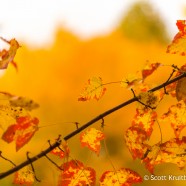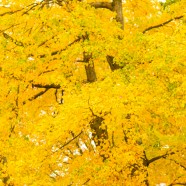Neon Glow
These leaves have a neon glow! Taken before the rain and wind of the last couple of days eliminated a lot of our fall foliage until 2016, the trees have been hauntingly beautiful as we approach Halloween. What a fiery feel to the landscape. Please remember that if you can leave the leaves where they fall it is better in all regards. It will save you time, possibly money and perhaps a sore back. It will help the environment locally and globally, saving unnecessary pollution (leaf blowers to trucks hauling them away) and making your yard look all the better as a natural fertilizer. Yes, it may...
Read MoreYellow Autumn
Even on the gray and cloudy days of late October there can still be plenty of bright yellow light reflected throughout our landscape. The brilliant golden hues reverberate through our forests as one last hurrah before the beginning of winter grabs at our region. Will we be retaining some of this implied warmth thanks to El Niño? It may be a record-shattering season for the Pacific Ocean which could mean we see above-average temperatures. This can actually spell more snow than usual if the Great Lakes remain open and if the jet stream steers major low pressure systems up the East Coast,...
Read MoreWehrle’s Salamander (Plethodon wehrlei)
Have you ever seen such a cool looking salamander? The Wehrle’s Salamander (Plethodon wehrlei) is a rather secretive salamander that inhabits rocks, logs and the currently colorful leaf litter that lines steep hillsides within the southwestern portion of New York State. Characteristically a dark slatey-gray with some white flecking on the sides, Wehrle’s salamanders are slender with robust legs and slightly webbed back feet. They are often confused with Slimy Salamanders (Plethodon glutinosus), a common salamander that often utilizes similar habitats and is black in color with...
Read MoreCommon Loons (Gavia immer)
There have been sizable groups of Common Loons (Gavia immer), with a few Red-throated Loons (Gavia stellata) occasionally mixed in, off Stratford, Connecticut lately. The waters of Long Island Sound have been a feeding frenzy for the species during this period with prolonged below-average temperatures, and some flocks like this have moved close to shore to dive for meals. On a dark and dreary day their grays blend in wonderfully with the water, making for exceptional camouflage. Scott Kruitbosch Conservation & Outreach Coordinator
Read MoreGray Fox (Urocyon cinereoargenteus)
Have you figured out the answer to our mystery woodland creature post yet? Do you give up? Well, that little mammal that was sitting behind all the brush is in fact a Gray Fox (Urocyon cinereoargenteus)! Although the Gray and Red Fox share the same family and some similar colorations, there are several distinct differences that separate these relatives. For starters, Gray Fox are called gray for a reason. Their coat is short and the fur down their back and tail are dark gray, ending with black at the tip of the tail. Compared to the Red Fox, and many other North American canids, Gray Fox are...
Read More








